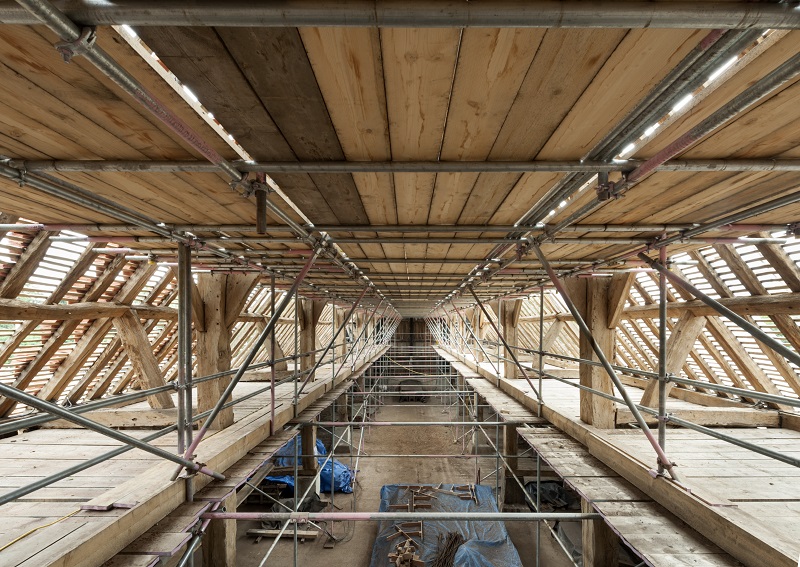Temporary Roof Scaffolding for Your Construction or Renovation Project
Temporary Roof Scaffolding for Your Construction or Renovation Project
Blog Article
Checking Out the Various Kinds of Scaffolding Made Use Of in Building Tasks
The construction sector relies greatly on numerous kinds of scaffolding to satisfy specific job needs, each offering distinct benefits and applications. Standard structure scaffolding supplies a sturdy foundation for basic tasks, while put on hold scaffolding is necessary for job on skyscraper frameworks.

Traditional Framework Scaffolding
Standard frame scaffolding is among the most widely made use of techniques in the building sector as a result of its effectiveness and convenience. This system consists of straight and vertical frameworks that are assembled to create a secure system for materials and employees. The primary elements include vertical articles, straight ledgers, and diagonal dental braces, which with each other give a strong structure that can sustain significant loads.
Among the key advantages of conventional structure scaffolding is its versatility to numerous construction projects, varying from residential buildings to big business structures. The modular layout enables easy assembly and disassembly, making it efficient for both lasting and short-term jobs. Additionally, the system can be tailored in height and size, suiting various building layouts and site conditions.
Security is vital in scaffolding applications, and traditional structure systems are equipped with guardrails and toe boards to avoid drops and make certain employee defense. Routine assessments and adherence to safety and security regulations are essential in keeping the integrity of the scaffold (Scaffolding). Overall, traditional structure scaffolding remains a fundamental choice in the building industry, supplying a dependable platform for labor and improving overall task efficiency

Suspended Scaffolding
Put on hold scaffolding provides a special option for building tasks that call for access to raised surfaces, especially in circumstances where standard frame scaffolding may be unwise. This kind of scaffolding is normally suspended from the roof or upper levels of a framework, using a system of ropes, platforms, and sheaves to create a working room that can be adapted to various elevations.
One of the key benefits of suspended scaffolding is its versatility. It can be easily rearranged or lowered to suit adjustments in construction demands, making it suitable for jobs such as home window installation, façade job, and maintenance on skyscraper structures. Furthermore, the marginal footprint of put on hold scaffolding enables far better use of ground room in metropolitan atmospheres, where area is commonly limited.
Safety and security is an essential factor to consider in the use of put on hold scaffolding. Generally, suspended scaffolding supplies a reliable and reliable service for accessing hard-to-reach locations in numerous building situations, improving both productivity and safety on website.
System Scaffolding
System scaffolding, often regarded as a modern-day solution in the scaffolding market, includes pre-engineered components that can be quickly put together and adapted for different construction tasks. Scaffolding. This type of scaffolding is defined by its modular layout, which permits for convenience and effectiveness on task sites, accommodating structural demands and various heights
Usually made from high-strength steel or aluminum, system scaffolding offers enhanced longevity and stability. The parts consist of upright posts, horizontal ledgers, and diagonal dental braces, which adjoin securely, ensuring a durable structure. The style frequently incorporates standard fittings, streamlining setting up and disassembly processes, therefore reducing labor time and costs.

Rolling Scaffolding
Rolling scaffolding is a versatile alternative to standard fixed scaffolding, made for mobility and convenience of use on building and construction websites. This sort of scaffolding is composed of a system sustained by frameworks with wheels, allowing employees to easily relocate it as needed. The mobility attribute considerably this link boosts efficiency, as it lessens downtime connected with disassembling and putting together taken care of scaffolding.
Generally constructed from light-weight materials such as aluminum or steel, rolling scaffolding offers a strong yet mobile option for tasks requiring frequent repositioning - Scaffolding. It is particularly useful in jobs such as painting, drywall installment, and electrical job, where access to various elevations and locations is needed
Safety is vital in rolling scaffolding style, with attributes such as locking wheels to stop unexpected activity when in usage, and guardrails to safeguard workers from drops. In addition, numerous models are adjustable in elevation, accommodating various task demands.
Cantilever Scaffolding

The layout of cantilever scaffolding normally includes utilizing brackets or arms secured to a structure or framework, making it possible for the system to extend exterior safely. Safety is extremely important; hence, these scaffolds need to be crafted to stand up to different loads and environmental conditions. Regular inspection and maintenance are vital to make certain architectural stability and worker security.
Cantilever scaffolding is preferred for its versatility and effective usage of room, making it important source a prominent selection in city environments where space constraints are common. Additionally, it helps with much easier access to high elevations, ultimately adding to the general effectiveness of construction projects. Just like all scaffolding types, proper training and adherence to security standards are important for workers using cantilever scaffolding.
Conclusion
Standard frame scaffolding offers stability, while suspended scaffolding provides adaptability for raised jobs. System scaffolding assists in fast setting up, and rolling scaffolding improves wheelchair for varying work atmospheres.
Traditional frame scaffolding offers a durable foundation for general jobs, while put on hold scaffolding is important for work on high-rise structures.Moving scaffolding is a functional alternative to conventional set scaffolding, developed for wheelchair and simplicity of use on building websites. As with all scaffolding kinds, correct training and adherence to safety criteria are essential for employees utilizing cantilever scaffolding.
Conventional frame scaffolding supplies security, while put on hold scaffolding uses adaptability for elevated jobs. System scaffolding promotes fast setting up, Visit Website and rolling scaffolding improves flexibility for varying job atmospheres.
Report this page